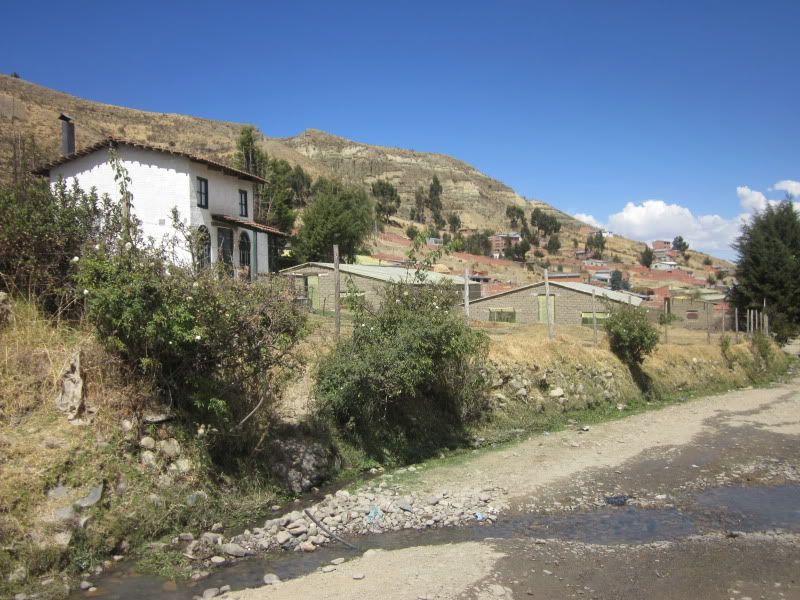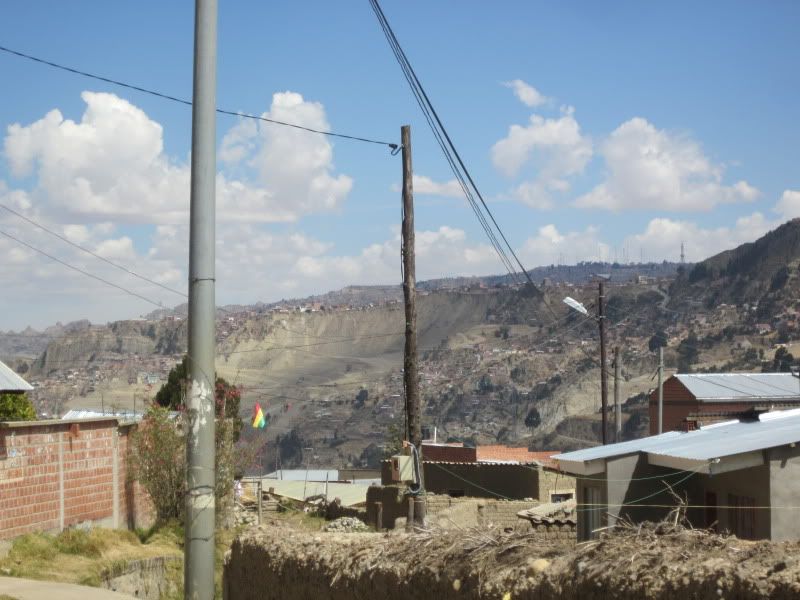Chicani is a neighborhood set on a shelf overlooking a valley just outside La Paz. La Paz is over a small mountain range from Chicani, and it's about a 30-40 minute drive away. The area was used for agriculture going back to pre-Columbian times. When the Spanish invaded, Chicani became an hacienda used as a dairy farm. It's fertile soil was once planted in alfalfa as forage for cows. The area's advantage, besides its good soil, is its access to water. Chicani is blessed with several springs. Additionally, the Spanish built a canal that diverts glacial melt from a nearby mountain to serve as irrigation water for Chicani, and the canal is still used today. Alas, today the water is more polluted than it was in Spanish times.

The canal

The spring
In 1952, Bolivia had a revolution, followed by agrarian reform in 1953. Chicani's hacienda was not broken up immediately, but once the hacendado (owner of the hacienda) was out of the picture, the peasants who worked the land became owners of the land they tilled. The parcels are not equal in size, but of course, even if they were, they would not be equal in quality anyway. Many current Chicani residents live on the land they received - or their families received - at that time. Others sold their land to people like Stephen, who bought a fraction of the original plot and built a house and a beautiful garden on it. The community distinguishes between who was there originally at the time the hacienda broke up and who moved in later (they call those people vecinos, or neighbors).
The community governs its two water sources (the springs and the canal) in different ways. The springs are owned by families who have owned the land they are on for decades. The owners of the springs give others access to the spring water for a fee. Stephen pays 300 Bolivianos per year (~$43) and his family uses the spring water for drinking water (which they boil before drinking).

A woman doing laundry in the canal.
The canal is used by many for free, but they pay a price in labor. Twice per year (at the end of winter, and at the end of spring), the community comes together to clean the canal of silt and plants growing in it. Anyone who uses the canal must show up. If a couple each uses the canal for irrigating their own separate agriculture ventures, then they both must show up.
The community selects five "mayors" each year to coordinate the cleanup. Each one has a list of names of people who must show up. They all walk to the top of the canal (Chicani is built on an incline) and check attendance. Then, they begin walking down, each mayor with a drummer and a fifth of the people who are there for the cleanup. As they call your name, you jump in the canal and clean a section of a few meters. When you finish, you walk to the very front and get assigned a new section. They do this until the canal is clean.
While this takes place, grain alcohol is distributed to each person cleaning the canal. At the very bottom, there is a feast. Because there are so many people there, each person does not have to do very much work, but they are all completely wasted by the time they finish.
Chicani's dairy farming roots are still apparent, as it is still home to no shortage of Holstein and Guernsey cows (as well as a few Angus beef cattle). Often they are on tiny plots with no possibility for grazing. The pictures below are from the local cheese maker, who has some Holsteins, some Guernseys, and an Angus. Stephen described how he used local resources:

Barley straw, purchased from the Altiplano (the high plain in the Andes), as feed

Corn stalks, from the Andean valleys, also for cattle feed.

Manure, for fertilizer for the family's garden.

Holsteins in front, Guernseys in back.

A few Guernsey cows.
I asked about the Angus cow, and Stephen said often cows are brought here for fattening. We walked on and found a few more cows. Here, Stephen pointed out that the cows were of three different ages, a way of managing risk for the farmer. Notice the confined conditions these cows are kept in.



Cows are often sold in June, because the community has a big annual party in early August each year and families need money for costumes, food, alcohol, etc. A cow can sell for 5000 Bolivianos ($715).
So here's the funny story: The big party was a few weeks ago. Beforehand, Stephen saw his neighbor out at midnight, painting his adobe wall white. Stephen asked him why.
Turns out, during the party, there is an abundance of drunk people and a shortage of bathrooms. The drunks walk up to Stephen's neighbors wall and let loose there - #1 and #2. Stephen's neighbor does not like that they do this. He figured this year, he would catch them. Anyone who poops near his wall will end up with a rear end covered in white paint. And he can catch and confront them for it. Apparently, the plan worked out quite well.
A friend advised me that Bolivia has amazing passionflowers, and I spotted one on our walk. This is a "tumbo," used as a popular ice cream flavor here. Another type of passionfruit is called mocomoco ("Moco" is Spanish for snot), but we did not see that one.

Tumbo flower

Passionfruits beginning to form.

Inside an underripe tumbo.
Here is a farm that Stephen calls "Blue Ribbon Farm." It goes down a terraced slope, and Stephen says the farmer meticulously maintains it and rotates crops each year, giving each area some time to lay fallow as well. You can see the bright green at the bottom planted in wheat, the middle planted in onions, and I think the top area planted in lettuce. The cold air sinks into the valley so this land gets lots of nice, warm air.

Blue Ribbon Farm
Here is another nearby field, planted with wheat on the outside and fava beans on the inside. The farmer is perhaps using the wheat as a physical barrier to keep pests from the fava beans.

Favas and wheat
Now comes the sad part of this happy story. Chicani is one of the few areas near La Paz that has remained agricultural. One of the ways they have remained financially viable as farmers is by selling leafy greens like lettuce and spinach, often using greenhouses like the adobe ones shown below. Unfortunately, the warm, wet environment created in the greenhouses makes a great habitat for fungal plant diseases. Thus, the farmers here all use fungicides. Some are frugal, using very little; others use it liberally to make sure that the fungus is absolutely dead.

Greenhouses
We had a very short walk and did not see too much other livestock besides cows (although we heard a pig), but I was able to get a good picture of one of the common chicken breeds around here, and a very distant picture of the breed that interested me the most, the one with feathered feet, and a partridge pattern on its feathers. Seeing a full-grown one from afar reminded me of silkies, and I just checked and they do come in a patridge pattern (pics). So maybe that's it.

Hen

Maybe-a-silkie in the distance
And, on a sad note, a nearby area suffered a landslide this past March, and now all of the people who lived there are in a tent camp that we passed. The landslide occurred over 2 weeks during a long rain, so no lives were lost and people were able to rescue their possessions - but not their homes. Now they don't even have level land to rebuild on, so they are in tents.

Landslide
Once our walk was over, we finished at Stephen's beautiful house, where we ate chairo paceno for lunch. I've posted pictures and descriptions of this last year so I will not repeat that, but I want to share one thing. I saw a hummingbird with a green throat come and eat from each flower of a gorgeous red flower called "Cohete" (firecracker), shown below.

Cohete flower
No comments:
Post a Comment